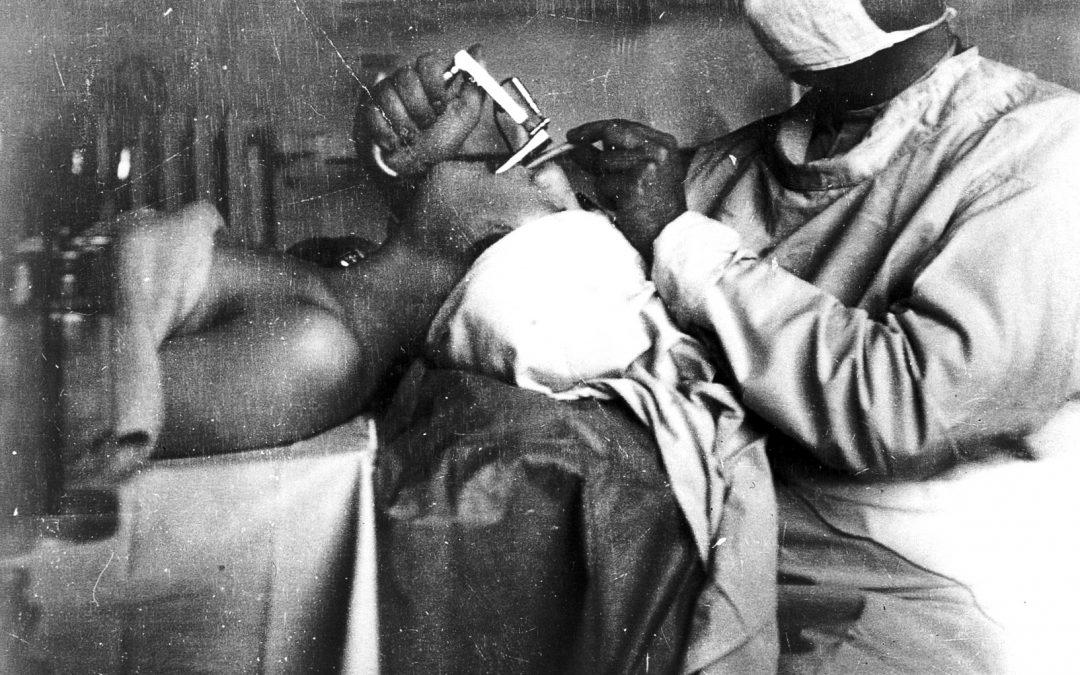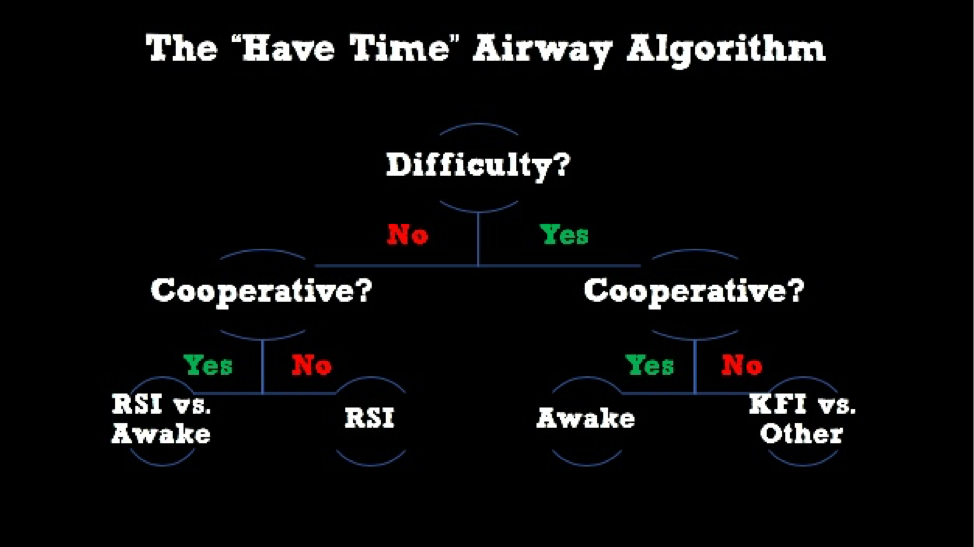Awake intubations are an uncommon procedure, so cognitively practicing the nuances can be critically important to success. Here, we present an updated practical guide on awake intubations in the ED intended to supplement a previously posted topic. You can see the original post here.
Who is the right patient?
Awake intubation must be considered in any patient in whom you are concerned about your ability to safely secure the airway using RSI. They may have one or more of any of the features below.
The Anatomically Difficult Airway:
- Will this patient be challenging to intubate?
- Small mouth opening, short neck, poor neck mobility, neck masses, previous neck surgery/radiation, trauma, burns, angioedema
- Will this patient be challenging to ventilate (BVM SGA, etc)?
- Facial hair, large body habitus, facial trauma, upper airway swelling…
The Physiologically Difficult Airway: optimize what you can. “Resuscitate before you intubate”:
- Refractory hypotension
- Refractory hypoxia
- Severe acidosis
- Severe hypoventilation
- RV failure
There’s no magic number – presence of any or all of these factors warrant a risk assessment of RSI and consideration of awake intubation by the ED physician.
What does the evidence say?
Awake intubation IS within the domain of Emergency Medicine with multiple expert groups publishing guidelines or consensus statements to this effect. These groups have either directly contained emergency physicians such as the AIME Airway group1, the Canadian Airway Focus Group (2013)2, and the Society of Airway Management (2021)3; or published statements with emergency medicine within the target scope such as the American Society of Anesthesiologists (2022) guideline4.
Awake intubation is safe, when performed correctly. This comes from Anesthesiology literature as, unfortunately, published Emergency Medicine literature is still not available.
- 2015 retrospective study of 1554 awake intubations: 98% success rate5
- 2016 retrospective study of 1085 awake intubations: 99% success rate, 1.6% complication rate6
- 2017 prospective study of 600 awake intubations: 99% success rate, 11% complication rate (vast majority being minor)7
Awake intubation likely improves patient outcomes. This also comes from Anesthesiology literature.
- NAP4 (2011) identified several cases where awake fiberoptic intubation was indicated but not used resulting in poor outcomes, and in many cases awake intubation would have avoided these problems.8
- Difficult Airway Society (2019) literature/database review found significantly lower rate of can’t intubate can’t oxygenate situations in awake intubations compared to intubations under anesthesia.9
How do I do it?
There are many accessible techniques to awake intubation with several step-by-step videos published publicly online by the AIME Airway group.
Keys to Success:
- Coach your patient! There is no better way to facilitate cooperation and anxiolysis than explaining the procedure step-by-step, warning them of any potential uncomfortable sensations before they happen, and providing reassurance.
- Pre-oxygenate as per standard protocol. Continue oxygenation via nasal prongs or high-flow during the procedure.
- Be judicious with analgesia and anxiolysis PRN: use of these medications does increase the risk of complications and should be dosed as low as possible just to facilitate cooperation.
- If using a fiberoptic scope, consider use of a Williams airway to help direct the tube above the glottis. The entire Williams airway can be gently moved to guide the scope once inserted as well.
- Once the tube is passed:
- Do NOT inflate the cuff right away: awake patients will generate tolerate an uncuffed tube fairly well, but inflating the cuff will be very uncomfortable and distressing.
- Confirm tube placement using end-tidal CO2 as per usual protocol.
- Initiate post-intubation sedation. As sedation comes into effect, inflate the cuff and attach to mechanical ventilation.
Where can things go wrong?
- Topicalization:
- Laryngeal/glottic dyspnea: patients will feel short of breath during topicalization. This is expected and safe. Reassurance is all the patient will need.
- Failure of topicalization: take your time and do this step systematically and carefully. This is where things can and will go wrong, and it’s often due to being rushed.
- Airway obstruction: case reports have been published but practically speaking this complication is extremely rare. Be aware and prepared for it, but it shouldn’t push you away from performing the technique.
- Plan B: ALWAYS have a back-up plan prepared at the bedside. In most cases, this means RSI equipment prepared and medications drawn up in the room, and any other airway adjuncts open and within reach. Consider opening a surgical airway kit and marking the neck in severe cases.
- If awake intubation fails and the patient remains stable, back off and call for help.
- If awake intubation fails and in a forced to act situation, there should be no delay to implementing the backup plan.
- Local anesthetic systemic toxicity: using the AIME Airway topicalization technique and no more than 8cc of 4% aqueous lidocaine will keep you below the maximum dose of 9mg/kg of topical lidocaine for the vast majority of patients. Monitor and be prepared for LAST, but stay within the above limits and you will likely never encounter this situation.
Bottom Lines:
- Recognize it! A number of our patients needing intubation in the ED are candidates for an awake intubation, particularly the physiologically difficult cases, and we almost always have more time than we think. You don’t always have to do it, but you should always consider it.
- Awake intubation, when performed correctly, is a safe, low risk, accessible technique that should be considered first-line in any airway where RSI may jeopardize patient safety.
- Every awake intubation should have a backup plan and exit strategy ready to go at the bedside (e.g. RSI equipment and drugs drawn up, surgical airway equipment kit ready, etc.). There should be no delay to implementing plan B if awake intubation fails – it’s what you would have done anyway.
References
1. Kovac, G., & Law, J. Airway Management in Emergencies: Open Access Textbook. https://aimeairway.ca/book#/
2. Law, J., Broemling, N., Cooper, R., Drolet, P., Duggan, L., et al. (2013). The difficult airway with recommendations for management – Part 2 – The anticipated difficult airway. Canadian Journal of Anesthesia, 60, 1119-1138.
3. Komas, R., Clark, G., Sakles, J., Foley, L., & Mosier, J. (2021). Evaluation and Management of the Physiologically Difficult Airway: Consensus Recommendations From Society for Airway Management. Anesthesia & Analgesia, 132(2), 395-405.
4. Apfelbaum, J., Hagberg, C., Connis, R., Abdelmalak, B., Agarkar, M., et al. (2022). 2022 American Society of Anesthesiologists Practice Guidelines for Management of the Difficult Airway. Anesthesiology, 136, 31-81.
5. Law, J., Morris, I., Brousseau, P., de la Ronde, S., & Milne, A. (2015). The incidence, success rate, and complications of awake tracheal intubation in 1,554 patients over 12 years: an historical cohort study. Canadian Journal of Anesthesia, 62, 736-744.
6. Joseph, T., Gal, J., DeMaria Jr, S., Lin, H., Levine, A., et al. (2016). A Retrospective Study of Success, Failure, and Time Needed to Perform Awake Intubation. Anesthesiology, 125, 105-114.
7. El-Boghdadly, K., Onwochei, D., Cuddihy, J., & Ahmad, I. (2017). A prospective cohort study of awake fibreoptic intubation practice at a tertiary centre. Anaesthesia, 72, 694-703.
8. Cook, T., Woodall N., & Frerk, C. (2011). 4th National Audit Project of The Royal College of Anaesthetists and The Difficult Airway Society (NAP4) Major Complications of Airway Management in the United Kingdom.
9. Ahmad, I., El-Boghdadly, K., Bhagrath, R., Hodzovic, I., McNarry, A., et al. (2019). Difficult Airway Society guidelines for awake tracheal intubation (ATI) in adults. Anaesthesia, 1-20.




Trackbacks/Pingbacks